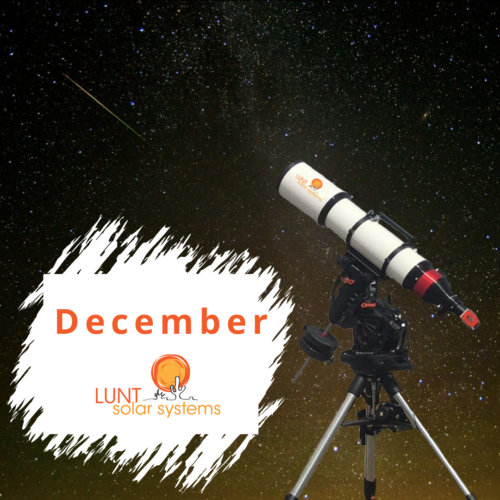
- Dec 8 – Full Moon
- Dec 8 – Mars at Opposition
- Dec 13, 14 – Geminids Meteor Shower
- Dec 21 – Winter Solstice
- Dec 21 Mercury at Greatest Eastern Elongation
- December 21, 22 Ursids Meteor Shower
- December 23 – New Moon
- December 23 starting at 12 p.m. through January 1 – Lunt Solar Annual Holiday Shutdown
- As seen on seasky.org
As the cold winter air settles in, December starts off with a Full Moon known as the Cold Moon on the 8th. Early Native American tribes gave it this name because the nights this time of year are long, dark and you guessed it cold. It is also known as the Moon Before Yule. Check the Moon calculator for the exact time of this Full Moon’s arrival in your area.
Also on the 8th we have Mars at Opposition. This will be the best time to view and photograph Mars. A medium sized telescope will allow you to see some of the dark details on the planets orange surface. It will be brighter than at any other time of year and visible all night long.
The Meteor shower season continues with the Geminids Meteor Shower and we are very excited!! This shower is considered by many to be the best to grace the skies and is labeled the King of the Meteor Showers. It runs annually from Dec 7-17th. This year peaking on the night of the 13th morning of the 14th. It produces up to 120 multicolored meteors per hour. It is produced by the asteroid known as 3200 Phaethon, which was discovered in 1982. The waning moon will block out the fainter meteors this year, but don’t worry the Geminids are so bright and numerous it will still be a good show. Best viewing will be after midnight in a dark location. Look toward the constellation Gemini, but the meteors can appear anywhere in the sky.
Lots happening on and around December 21st this year! Let’s start with what is known as the first day of “astronomical winter” in the Northern Hemisphere, the Winter Solstice lands on December 21st and is the shortest day of the year. As mentioned on timeanddate.com, “This effect is greatest in locations that are farther away from the equator. In tropical areas, the shortest day is just a little shorter than 12 hours; in the temperate zone, it is significantly shorter; and places within the Arctic Circle experience polar night, when the Sun does not rise at all.” For those in the Southern Hemisphere this day is known as the Summer Solstice and marks the 1st day of Summer.
December 21 will also be the best time to view the planet Mercury as it reaches greatest eastern elongation of 20.1 degrees from the Sun. It will be at its highest point above the horizon in the evening sky. Look for the planet low in the western sky just after sunset.
And finally, also on December 21st and the 22nd we have the peak of the Ursids Meteor Shower. This shower runs annually from the 17th through the 25th and is a more minor shower with only about 5-10 meteors per hour. This years full moon will pose a problem with seeing the faint meteors but keep your eyes open for the brightest ones in the wee hours of the morning. Meteors will radiate from Ursa Minor but can appear anywhere in the night sky.
The New Moon happens on December 23rd. No Moonlight makes this the best time of the month to view faint objects such as galaxies and star clusters.
***Lunt Solar Offices will be closed for our Annual Holiday Shutdown starting December 23rd at 12:00 p.m. through January 1st.
2023 is going to be full of surprises so keep an eye out for the January newsletter to see what will be NEW in Lunt products and programs too. No spoilers right now though!